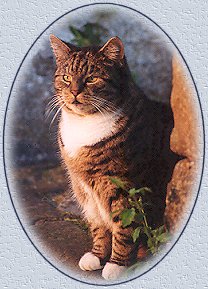

Articles in Featuring Felines are written by
Patrick Roberts
Copyright © 2003-18 Purr 'n' Fur UK
Certain features on these pages use JavaScript

|

Articles in Featuring Felines are written by Certain features on these pages use JavaScript |
[ Home | Famous | Featuring | Fans | Fabled | Folios | Fun | Philately | Fragments | Flotsam ]
Left-click thumbnails for enlargements (JavaScript should be enabled)
By the time of the reign of Catherine the Great (1762-96) there was a substantial number of Winter Palace cats. They survived the storming of the building by the Bolsheviks in 1917, but the siege of Leningrad (as it was then called) in 1941-44, during the Second World War, meant that their descendants succumbed to disease, starvation or the needs of the famished human population. After three 'catless' years, they were reintroduced as soon as possible after the war; museum legend has it that a special train travelled nationwide to recruit suitable felines for service.
There was an account (now archived) of the body of museum volunteers, including a small photo of some of them standing by a notice proclaiming 'Caution! Cats!' — and including a cat, of course! Reader Tom Nelson kindly sent us a photo of that sign (above left). The image top left of a volunteer holding a cat outside the Hermitage in winter is by Sergei Grachev of the St Petersburg Times.
Update 2017Early in September 2017 a fire broke out in the basement of the museum and although it was small and quickly extinguished, it was feared that some cats might have been caught in it. In fact four of them suffered from smoke inhalation and were rushed to the vets. The worst affected was Dusya, and it's reported that in fact she later died, while the others recovered. Links and further reading
|
||||||||||||
If you would like to comment please contact me,
Drop in at our Facebook page
Return to:
Featuring Felines index
for more museum inhabitants, and real-life stories and adventures of cats
Other sections:
Famous Felines
Fabled Felines
Feline Folios
Feline Fun
Fans of Felines
Feline Philately
Feline Fragments
Feline Flotsam
or visit the Purr 'n' Fur home page

Our featured feline at the head of the page is Socks, pictured in 2003 surveying his 'estate' in the early morning sunshine. Affectionately known as Soxy, he blossomed from a thin and hungry stray into a substantial and handsome cat who loved life and company, and his gentle ways endeared him to many friends. He is now no longer with us, but you can read more from his human companion here.
Copyright © Patrick Roberts & Purr 'n' Fur UK 2003-18
All rights reserved
Images and content (whether original or used at Purr 'n' Fur with permission) may NOT be reproduced
at another website or otherwise copied or used without prior permission.
Direct linking (hotlinking) to ANY images on this site is strictly forbidden.
If you want something,
!
Page created September 2006, with later revisions and additions